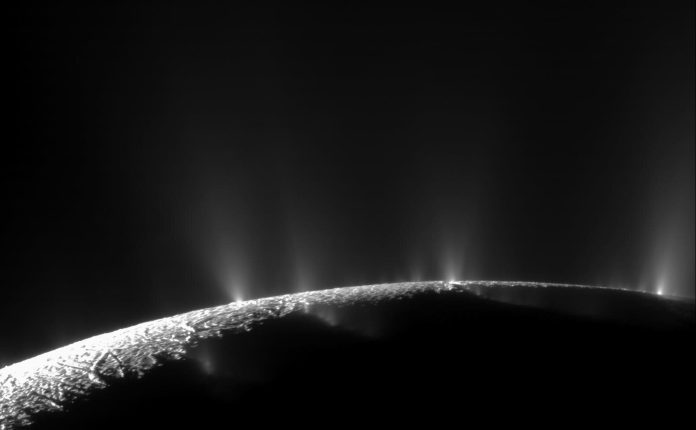
Jupiter’s moon Europa and Saturn’s moon Enceladus are known to have oceans beneath their icy crusts.
A recent NASA experiment suggests that if these oceans have life, signs of it, like organic molecules such as amino acids, could survive just below the surface ice despite the harsh radiation conditions on these moons.
This means that robotic landers sent to search for life wouldn’t have to dig very deep to find these important molecules.
Alexander Pavlov from NASA’s Goddard Space Flight Center led the study, which found that on Europa, amino acids could survive just under 8 inches (20 centimeters) of ice, particularly on the trailing hemisphere (the side opposite to the direction of its orbit).
On Enceladus, amino acids can survive less than a tenth of an inch (a few millimeters) below the surface, making them easier to detect.
The harsh surfaces of Europa and Enceladus are exposed to strong radiation from their planets’ magnetic fields and cosmic events like exploding stars.
However, their subsurface oceans are heated by the gravitational pull of their host planets and neighboring moons, potentially providing a habitable environment if they have necessary elements and energy sources for life.
The research team conducted experiments to see how amino acids, key building blocks for proteins in life, would hold up under these conditions.
Amino acids can form through biological processes or non-living chemical reactions, but certain types found on Europa or Enceladus might indicate life because they are used by Earth’s life forms to make proteins.
Proteins are crucial as they make enzymes that regulate chemical reactions and build structures within organisms.
To test this, researchers mixed amino acids with ice at extremely cold temperatures (minus 321 Fahrenheit or -196 Celsius) and exposed them to gamma rays, simulating the radiation they would face on Europa and Enceladus.
They also tested amino acids within dead bacteria and mixed with silicate dust to mimic potential interactions with meteorite material or the moons’ interiors.
The experiments measured how quickly amino acids break down, using this data to calculate how deep they would need to be to survive the radiation on these moons.
They found that amino acids degrade faster when mixed with dust but slower when embedded in bacterial material.
These results are promising for future missions aiming to find life on these moons. They show that amino acids can survive in conditions similar to Europa and Enceladus, especially if protected by biological material.
This means landers might not need to drill deep to find potential signs of life, making the search easier.
Pavlov highlighted that while amino acids degrade faster in silica-rich areas, they survive longer in biological samples under Europa and Enceladus-like conditions. This supports the idea of sending missions to these moons to detect life. The study suggests being careful when sampling silica-rich regions, as degradation rates are higher there.
This research offers valuable insights into how life’s building blocks might survive in harsh environments, bringing us closer to answering whether there’s life beyond Earth. Future missions to Europa and Enceladus could use these findings to design better strategies for detecting signs of life.



